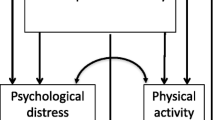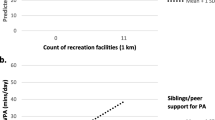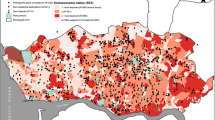Abstract
Crime is both a societal safety and public health issue. Examining different measures and aspects of crime-related safety and their correlations may provide insight into the unclear relationship between crime and children’s physical activity. We evaluated five neighborhood crime-related safety measures to determine how they were interrelated. We then explored which crime-related safety measures were associated with children’s total moderate-to-vigorous physical activity (MVPA) and MVPA in their neighborhoods. Significant positive correlations between observed neighborhood incivilities and parents’ perceptions of general crime and disorder were found (r = 0.30, p = 0.0002), as were associations between parents’ perceptions of general crime and disorder and perceptions of stranger danger (r = 0.30, p = 0.0002). Parent report of prior crime victimization in their neighborhood was associated with observed neighborhood incivilities (r = 0.22, p = 0.007) and their perceptions of both stranger danger (r = 0.24, p = 0.003) and general crime and disorder (r = 0.37, p < 0.0001). After accounting for covariates, police-reported crime within the census block group in which children lived was associated with less physical activity, both total and in their neighborhood (beta = −0.09, p = 0.005, beta = −0.01, p = 0.02, respectively). Neighborhood-active children living in the lowest crime-quartile neighborhoods based on police reports had 40 min more of total MVPA on average compared to neighborhood-active children living in the highest crime-quartile neighborhoods. Findings suggest that police reports of neighborhood crime may be contributing to lower children’s physical activity.

Similar content being viewed by others
References
Badland HM, Schoefield GM, Witten K, et al. Understanding the relationship between activity and neighbourhoods (URBAN) study: research design and methodology. BMC Public Health. 2009; 9(224): 1–11.
Bennett GG, McNeill LH, Wolin KY, Duncan DT, Puleo E, Emmons KM. Safe to walk? Neighborhood safety and physical activity among public housing residents. PLoS Med. 2007; 4(10): 1599–607.
Carver A, Timperio A, Crawford D. Playing it safe: the influence of neighbourhood safety on children’s physical activity—a review. Health Place. 2008; 14: 217–27.
Diez-Roux AV, Evenson KR, McGinn AP, et al. Availability of recreational resources and physical activity in adults. Am J Public Health. 2007; 97(3): 493–9.
Duncan DT, Johnson RM, Molnar BE, Azrael D. Association between neighborhood safety and overweight status among urban adolescents. BMC Public Health. 2009; 9: 289–97.
Foster S, Giles-Corti B. The built environment, neighborhood crime and constrained physical activity: an exploration of inconsistent findings. Prev Med. 2008; 47: 241–51.
Gomez JE, Johnson BA, Selva M, Sallis JF. Violent crime and outdoor physical activity among inner-city youth. Prev Med. 2004; 39: 876–81.
Lopez RP, Hynes HP. Obesity, physical activity, and the urban environment: public health research needs. Environ Heal. 2006; 5: 25–34.
Loukaitou-Sideris A. Is it safe to walk? Neighborhood safety and security considerations and their effects on walking. J Plan Lit. 2006; 20(3): 219–32.
Neckerman KM, Lovasi GS, Davies S, et al. Disparities in urban neighborhood conditions: evidence from GIS measures and field observation in New York City. J Public Health Policy. 2009; 30(Suppl. 1): S264–85.
Orleans CT, Kraft MK, Marx JF, McGinnis JM. Why are some neighborhoods active and others are not? Charting a new course for research on the policy and environmental determinants of physical activity. Ann Behav Med. 2003; 25(2): 77–9.
Roman CG, Knight CR, Chalfin A, Popkin SJ. The relation of the perceived environment to fear, physical activity, and health in public housing developments: evidence from Chicago. J Public Health Policy. 2009; 30(Suppl. 1): S286–308.
Romero AJ. Low-income neighborhood barriers and resources for adolescents’ physical activity. J Adolesc Health. 2005; 36: 253–9.
Babey SH, Hastert TA, Huang W, Brown ER. Sociodemographic, family, and environmental factors associated with active commuting to school among US adolescents. J Public Health Policy. 2009; 30(Suppl): S203–20.
Ding D, Sallis JF, Kerr J, Lee S, Rosenberg DE. Neighborhood environment and physical activity among youth: a review. Am J Prev Med. 2011; 41(4): 442–55.
Kerr J, Rosenberg D, Sallis JF, Saelens BE, Frank LD, Conway TL. Active commuting to school: associations with environment and parental concerns. Med Sci Sports Exerc. 2006; 38(4): 787–94.
Day K. Active living and social justice: planning for physical activity in low-income, black, and Latino communities. J Am Plan Assoc. 2006; 72(1): 88–99.
Pikora TJ, Giles-Corti B, Knuiman MW, Bull FC, Jamrozik K, Donovan RJ. Neighborhood environmental factors correlated with walking near home: using SPACES. Med Sci Sports Exerc. 2006; 38(4): 708–14.
Dannenberg AL, Jackson RJ, Frumkin H, et al. The impact of community design and land-use choices on public health: a scientific research agenda. Am J Public Health. 2003; 93(9): 1500–8.
Bursik RJ Jr, Grasmick HG. Neighborhoods and crime: the dimensions of effective community control. Lanham, MD: Lexington Books; 1993.
Loukaitou-Sideris A, Eck JE. Crime prevention and active living. Am J Health Promot. 2007; 21(Suppl 4): 380–9.
Sun IY, Triplett R, Gainey RR. Neighborhood characteristics and crime: a test of Sampson and groves’ model of social disorganization. West Criminol Rev. 2004; 5(1): 1–16.
Valentine G, McKendrick J. Children’s outdoor play: exploring parental concerns about children’s safety and the changing nature of childhood. Geoforum. 1997; 28(2): 219–35.
Mijanovich T, Weitzman BC. Which ‘broken windows’ matter? School, neighborhood, and family characteristics associated with youths’ feelings of unsafety. J Urban Health. 2003; 80(3): 400–15.
Williams K, Green S. Literature review of public spaces and local environments for the cross cutting review. Department of Transport, Local Government and the Regions Research Analysis and Evaluation Division Final Report. http://johannes.lecture.ub.ac.id/files/2012/09/Literature-Review-of-Public-Space-and-Local-Environments-for-the-Cross-Cutting-Review.pdf. Published 2001. Accessed July 14, 2010.
Brown HS III, Perez A, Mirchandani GG, Hoelscher DM, Kelder SH. Crime rates and sedentary behavior among 4th grade Texas school children. Int J Behav Nutr Phys Act. 2008; 5: 28–34.
Hillier A. Childhood overweight and the built environment: making technology part of the solution rather than part of the problem. AAPSS. 2008; 615: 56–82.
Saelens BE, Sallis JF, Frank LD, et al. Obesogenic neighborhood environments related to child and parent obesity: the Neighborhood Impact on Kids (NIK) study. Am J Prev Med. 2012; 42(5): e57–64. doi:10.1016/j.amepre.2012.02.008.
Frank LD, Saelens BE, Chapman J, et al. Objective assessment of obesogenic environments in youth: GIS methods and spatial findings from the Neighborhood Impact on Kids (NIK) study. Am J Prev Med. 2012; 42(5): e47–55. doi:10.1016/j.amepre.2012.02.006.
Millstein RA, Cain KL, Sallis JF, et al. Development, scoring, and reliability of the Microscale Audit of Pedestrian Streetscapes (MAPS). BMC Public Health. 2013; 13: 403. doi:10.1186/1471-2458-13-403.
United States Census Bureau. TIGER (Topologically Integrated Geographic Encoding and Referencing system), 2007 TIGER/Line® Shapefiles main page. http://www.census.gov/cgi-bin/geo/shapefiles/county-files?county=06073. Accessed June 13, 2011.
Saelens BE, Sallis JF, Black JB, Chen D. Neighborhood-based differences in physical activity: an environment-scale evaluation. Am J Public Health. 2003; 93: 1552–8.
Ding D, Bracy NL, Sallis JF, et al. Is fear of stranger danger related to physical activity among youth? Am J Health Promot. 2012; 26(3): 189–95.
Foster S, Giles-Corti B, Knuiman M. Neighbourhood design and fear of crime: a socio-ecological examination of the correlates of residents’ fear in new suburban housing developments. Health Place. 2010; 16: 1156–65.
Freedson PS, Pober D, Janz KF. Calibration of accelerometer output for children. Med Sci Sports Exerc. 2005; 37(suppl 11): S523–30.
Freedson PS, Sirard J, Debold E, et al. Calibration of the Computer Science and Applications, Inc. (CSA) accelerometer. Med Sci Sports Exerc. 1997; 29(Suppl. 5): 45.
Kneeshaw-Price SH, Saelens BE, Sallis JF, et al. Children’s objective physical activity by location: why the neighborhood matters. Pediatr Exerc Sci. 2013; 25: 468–86.
Sampson RJ, Raudenbush SW, Earls F. Neighborhood and violent crime: a multilevel study of collective efficacy. Science. 1997; 277: 918–24.
Franzini L, Taylor W, Elliott MN, et al. Neighborhood characteristics favorable to outdoor physical activity: disparities by socioeconomic and racial/ethnic composition. Health Place. 2010; 16: 267–74.
Veitch J, Bagley S, Ball K, Salmon J. Where do children usually play? A qualitative study of parents’ perceptions of influences on children’s active free-play. Health Place. 2006; 12: 383–93.
Weir LA, Etelson D, Brand DA. Parents’ perceptions of neighborhood safety and children’s physical activity. Prev Med. 2006; 43: 212–7.
Doyle S, Kelly-Schwartz A, Schlossberg M, Stockard J. Active community environments and health: the relationship of walkable and safe communities to individual health. J Am Plan Assoc. 2006; 72(1): 19–31.
Sallis JF, Saelens BE. Assessment of physical activity by self-report: status, limitations, and future directions. Res Q Exerc Sport. 2000; 71(2): 1–14.
Dossegger A, Ruch N, Jimmy G, et al. Reactivity to accelerometer measurement of children and adolescents. Med Sci Sports Exerc. 2014; 46(6): 1140–6.
Kneeshaw-Price SH. Safe streets are healthy streets: The role of crime and traffic in neighborhood health. Transportation Alternatives Web site. http://www.transalt.org/files/newsroom/reports/2012/Safe_Streets_are_Healthy_Streets.pdf. Published December 2012. Accessed Dec 1, 2012.
Cohen L, Davis R, Lee V, Voldovinos E. Addressing the intersection: Preventing violence and promoting healthy eating and active living. Executive Summary. Prevention Institute website. http://www.preventioninstitute.org/. Published 2010. Accessed Jan 11, 2012.
Acknowledgments
The authors would like to thank all of the NIK children and parents for their participation. We would also like to thank Ms. Chris Haley of the San Diego Police Department and her team for granting the request for data and compiling the cross-street level police-reported crime data used in the current study; Dr. Matthew Dunbar, Tim Thomas, and Mike Babb of the University of Washington’s Center for Studies in Demography and Ecology for their insight and assistance with GIS and geocoding the San Diego police-reported crimes; and Dr. Robert Crutchfield, Dr. Nicole Bracy, Dr. Amy Hillier, and Dr. Kris Day for their time and insight regarding crime data.
Funding
The NIK project was supported by the NIH National Institute of Environmental Health Sciences (NIEHS R01 ES014240). Partial support for this research also came from a Eunice Kennedy Shriver National Institute of Child Health and Human Development research infrastructure grant, 5R24HD042828, to the Center for Studies in Demography and Ecology at the University of Washington. Finally, the first author received training funding (NCCR TL1 RR025016) from the National Center for Research Resources (NCRR), a component of the National Institutes of Health (NIH), to conduct this research.
Author information
Authors and Affiliations
Corresponding author
Additional information
The views and opinions expressed in this article are those of the authors and do not necessarily reflect the views, policy, or position of the New Jersey State Department of Health.
At the time of writing, Dr. Kneeshaw-Price was affiliated with the Department of Health Services, University of Washington, Seattle, WA, USA.
Rights and permissions
About this article
Cite this article
Kneeshaw-Price, S.H., Saelens, B.E., Sallis, J.F. et al. Neighborhood Crime-Related Safety and Its Relation to Children’s Physical Activity. J Urban Health 92, 472–489 (2015). https://doi.org/10.1007/s11524-015-9949-0
Published:
Issue Date:
DOI: https://doi.org/10.1007/s11524-015-9949-0




